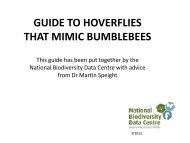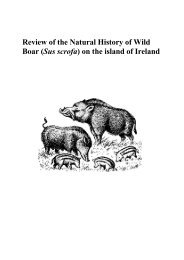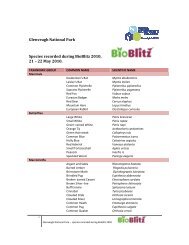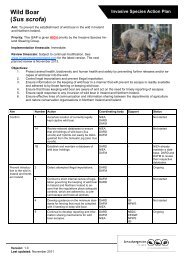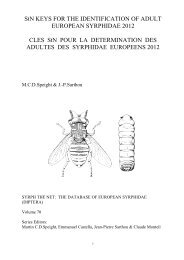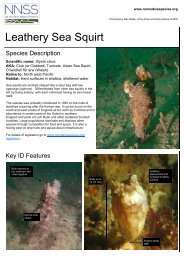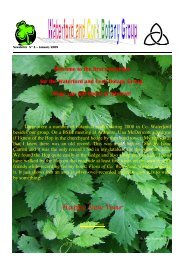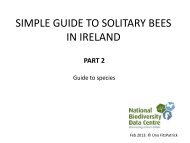StN DATABASE: CONTENT AND GLOSSARY OF ... - Pollinators
StN DATABASE: CONTENT AND GLOSSARY OF ... - Pollinators
StN DATABASE: CONTENT AND GLOSSARY OF ... - Pollinators
Create successful ePaper yourself
Turn your PDF publications into a flip-book with our unique Google optimized e-Paper software.
In Atlantic parts of Europe the fissures provide a cold, humid microclimate where shade-tolerant<br />
vascular plants such as Geranium robertianum and Ceterach officinale occur, as well as formations of<br />
herbaceous species typical of calcareous woodland; the small pockets of soil are occupied by<br />
communities of Mesobromion (e.g. Seslerio-Mesobromenion). Marginal areas of Geranium<br />
sanguineum may occur. Scrub (e.g. Corylo-Fraxinetum, Prunetalia spinosae) and patches of heath and<br />
moorland vegetation may be present, but should be treated as additional habitats. These pavements may<br />
be subject to severe winds, so that isolated shrubs can only there survive in prostrate growth-form<br />
(e.g.Dryas octopetal, Juniperus).<br />
In Sweden, limestone blocks are larger and cracks are smaller. The species composition reflects a<br />
more continental, drier and cooler climate. The pavements are mostly exposed with scattered cushions<br />
of bryophytes, more seldom covered by a thin layer of soil. The surface is covered by Sedum album,<br />
Cerastium pumilum, C.semidecandrium, lichens (Aspicilia calcarea, Thamnolia vermicularis,<br />
Verrucaria nigrescens) and bryophytes (Tortella tortuosa, Grimmia pulvinata). The vegetation in the<br />
cracks contains Gymnocarpium robertianum, Asplenium ruta-muraria, A.trichomanes ssp.<br />
quadrivalens and, occasionally, bushes of Prunus spinosa, Fraxinus excelsior, Cotoneaster spp., Rosa<br />
spp.<br />
In sub-mediterranean conditions, limestone pavements may carry patches of thermophilous Quercus<br />
scrub, with an understory of Buxus - these should be regarded as separate habitats. The pockets of<br />
grassland present are variable in character but would normally be described as xeric, and unimproved<br />
(i.e.CORINE 34.5).<br />
limnocrene, spring/flush: springs emerging in small pools. Limnocrens emerging in larger water<br />
bodies such as lakes or dead arms are not covered here.<br />
lowland, heath: CORINE 31.22, with the exclusion of all mediterranean, iberian, and alpine<br />
communities; CORINE 31.23.<br />
CORINE 31.22: SUB-ATLANTIC CALLUNA-GENISTA HEATHS; Calluno-Genistion pilosae p.;<br />
Low Calluna heaths often rich in Genista, mostly of the North Sea lowlands. Similar formations<br />
occuring in British upland areas are also included here.<br />
CORINE 31.23: ATLANTIC ERICA-ULEX HEATHS; Ulicenion minoris; Daboecenion cantabricae<br />
p.; Ulicion maritimae; heaths rich in gorse (Ulex) of Atlantic margins<br />
lowland improved grassland: improved pasture and meadow occurring at altitudes up to, and<br />
including, that of Fagus forest: CORINE 38.1, 38.2.<br />
CORINE 38.1: MESOPHILE PASTURES; Cynosurion; regularly grazed mesophile pastures, fertilised<br />
and on well-drained sites, with Lolium perenne, Cynosurus cristatus, Poa ssp., festuca ssp., Trifolium<br />
repens, Leontodon autumnalis, Bellis perennis, Ranunculus repens, R.acris, Cardamine pratensis; they<br />
are most characteristic of the Euro-Siberian zone, but extend to Atlantic Iberia and the Cordillera<br />
Central, the Apennines and the supra-Mediterranean zone of Greece.<br />
CORINE 38.2: LOWL<strong>AND</strong> HAY MEADOWS; Arrhenatherion, Brachypodio-Centaureion nemoralis;<br />
mesophile hay meadows of low altitudes, fertilized and well-drained, with Arrhenatherion elatius,<br />
Trisetum flavescens, Anthriscus sylvestris, Heracleum sphondylium, Daucus carota, Crepis biennis,<br />
Knautia arvensis, Leucanthemum vulgare, Pimpinella major, Trifolium dubium, Geranium pratense;<br />
they are most characteristic of the Euro-Siberian zone, but extend to Atlantic Iberia, the Cordillera<br />
Central and Montseny, to the Apennines and to the supra-Mediterranean zone of Greece.<br />
lowland, tall herb communities: tall-herb communities at altitudes up to, and including, that of Fagus<br />
forest. CORINE 37.1: meadowsweet stands and related communities. Filipendulion ulmariae i.a.<br />
Hygrophile tall herb strips of fertile alluvial stream banks, often dominated by Filipendula ulmaria,<br />
and tall herb stands (F.ulmaria, Angelica sylvestris) colonising humid hay meadows and pastures after<br />
more or less long discontinuation of mowing or grazing; characterstic species are Filipendula ulmaria,<br />
Angelica sylvestris Achillea ptarmica, Cirsium palustre,Deschampsia cespitosa, Epilobium hirsutum,<br />
Geranium palustre, Veronica longifolia, Scutellaria hastifolia, Eupatorium cannabinum, Lysimachia<br />
vulgaris, Lythrum salicaria, Phalaris arundinacea, Polygonum bistorta, Valeriana officinalis.<br />
CORINE 37.7: humid tall herb fringes. Convolvuletalia sepium, Glechometalia hederaceae p.<br />
(Calystegio-Alliarietalia). Watercourse veil and shady woodland edge communities.<br />
lowland unimproved grassland (general), unimproved grassland: unimproved grasslands occurring at<br />
altitudes up to, and including, that of Fagus forest. Used in contradistinction to montane/subalpine<br />
28



